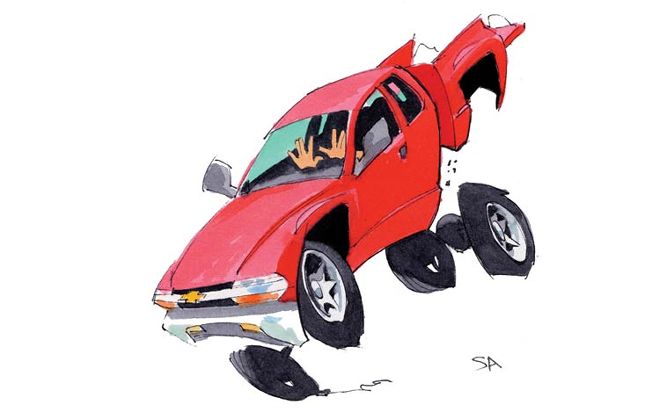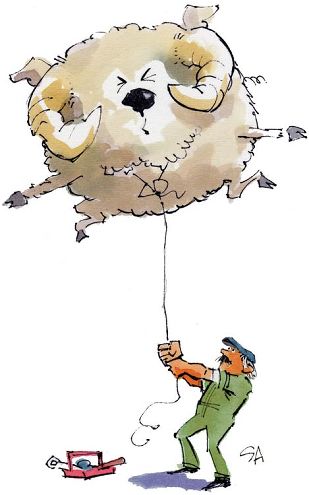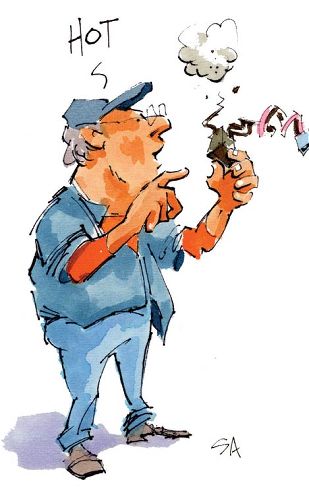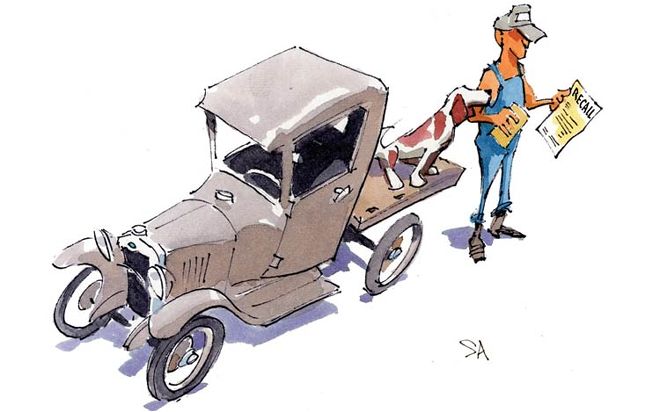
| stopping My Chevy
Stopping My ChevyQ: Can the brakes on a 4WD half-ton 2000 Chevy Silverado be upgraded to one-ton brakes? What modifications are needed, if any?
A: The original-equipment brakes on a 2000 Chevy half-ton truck could certainly be better. I found 20 brake-related technical service bulletins and recalls. Unfortunately, installing brakes from a one-ton onto a half-ton truck isn't practical. A lot of the one-ton parts are bigger, including the spindles, hubs, and axles where the calipers and rotors or drums bolt on. But aftermarket brake upgrade kits that can enhance braking performance, reduce brake noise, and increase brake-pad longevity are available from Wilwood (www.wilwood.com), Brembo (www.brembo.com), SSBC (www.stainlesssteelbrakes.com), and Baer (www.baer.com), to name a few. Most have a selection of kits with variances in rotors, performance pads, and multi-piston calipers to fit your application, performance needs, and budget. As an example, Brembo, for a few hundred dollars per axle, produces a Sport Brake System composed of cross-drilled or slotted rotors and performance composition pads, which will bolt onto your Chevy. Or for several thousand dollars, you can buy Brembo's GT Big Brake Upgrade that includes the rotors, pads, hardware, and a choice of four-, six-, or eight-piston calipers in a variety of color schemes.

| ram Fuel Pressure
Cummins Ram Fuel PressureQ: I have a 2001 Dodge Ram 2500 with a 5.9-liter 24-valve Cummins turbodiesel. The aftermarket fuel-pressure gauge is showing erratic fuel pressure. I bought the truck used with 133,000 miles on it. When I bought it, the fuel pressure was consistent (about 14 psi at idle, 10 while cruising). Now, the gauge fidgets between 12 and 15 psi at idle and 9-10 psi while cruising. Is this inconsistent fuel pressure a sign that the lift pump is starting to go, or is this just a bad gauge? The fuel-pressure gauge is reading pressure prior to the fuel going to the injector pump. I do know that the truck had a new injector pump put on before I bought it.
A: The transfer (lift) pump failures you're talking about were reportedly dealt with by a DaimlerChrysler corporate recall, Customer Satisfaction Notification number 878. The recall involved all 2000-2001 5.9-liter Cummins diesel-equipped Rams built at the St. Louis North, Lago Alberto, or Saltillo assembly plants, falling under certain vehicle I.D. production date codes. The repair consisted of transfer-pump replacement due to the potential for premature internal armature shaft bushing wear. This premature wear could result in a no-start condition following fuel-filter replacement. Thanks for including your Ram's VIN; your specific truck wasn't involved in the recall. Yours was built at the St. Louis North plant at a later date, so your transfer pump shouldn't be from the problem batch of parts. Adequate low-pressure fuel delivery from the fuel tank to the injection pump by means of the transfer pump is tested with special tools that inspect for both volume and pressure. Dodge service information provides a detailed description of an updated transfer-pump diagnostic procedure. Your truck's erratic fuel-pressure gauge could be due to a problem with the pressure sending unit or a bouncy gauge not damping the fuel pressure reading sufficiently, which could be confirmed with a properly functioning test gauge. If it's not the gauge, have the system properly tested by Dodge service or a qualified diesel technician.
Knocking on an S-10 DoorQ: I'm working on a 1998 Chevy S-10 Blazer with 4WD and the 4.3-liter V-6. When driving 50-55 mph and accelerating hard, the engine loses power. There's no response from the throttle and it occasionally dies, but usually it just loses power for about 30 seconds and then recovers. The "service engine soon" light sometimes comes on with a misfire or MAP code. The fuel pump, MAP sensor, PCM, TPS, CTS, alternator, battery, fuel filter, wires, cap, rotor, and plugs are all new, and the intake manifold gasket was replaced, among other things. The only thing left suspect is the fuel-injection assembly, which was removed but not replaced. The fuel-pressure regulator has also been replaced.
A: Sounds like you're running out of parts to replace and/or money to buy them. It could still be an ignition or fuel-delivery issue caused by a touchy component (although there aren't many left to replace) or a poor electrical connection in a vital system being disturbed by the hard acceleration, or maybe even contaminated fuel. But the first thing that comes to mind involves the knock sensor--the little guy that screws into the engine block and listens for noises. Under normal operation, the knock sensor will detect a spark knock or ping from the engine due to poor fuel, high temperatures, etc., and retard the ignition timing just a bit to keep things quiet and prevent long-term engine damage. But once in a while, the knock sensor will hear a real mechanical knock in the engine and retard the ignition timing to such an extreme that it causes a severe lack of power. Sounds crazy but it does happen, and it won't set a knock-sensor trouble code, because as far as the system is concerned it's just doing its job. The easiest way to test the knock sensor is to disconnect it and road test the vehicle. If you then have plenty of power when you bang on the gas but also hear a loud banging noise under the hood, then eureka, you've diagnosed the problem, but probably need an engine--and more money.

| blower Problems
TRAILBLAZER Blower ProblemsQ: I have a 2006 Chevy Trailblazer with the I-6. The blower motor has completely stopped working. At first it would stop, then start again, or if I rounded a turn it would restart. Now it's completely dead. Should I change the fuse?
A: Fuses are a one-time deal--when they go, they go. We typically rule them out as the cause of an on-again, off-again circuit or component like a blower motor stopping and starting around turns. Once the filament within a fuse burns through, the circuit it was protecting goes off and stays off, until the fuse is replaced. And the new fuse will most likely burn out again if the short circuit that tripped it in the first place isn't located and repaired. Now that your blower motor is completely inoperable it should be easy for a technician to quickly diagnose the problem. It may be the motor itself, the resistor module, relay, switch, or a poor connection somewhere in the blower-motor wiring. There are two TSBs involving TrailBlazer blower-motor operation. Bulletin 06-01-39-002A involves replacement of the blower-motor resistor module if the motor is inoperable at temperatures of -10 degrees Fahrenheit and below. If you're not running your SUV that cold, I'd focus more on TSB 05-01-38-012C, which involves blower-motor failure. This one requires replacement of the resistor module along with its connector. GM doesn't come right out and say there's an electrical overheat issue with the resistor module, but it does recommend cutting out any wiring you find covered with melted insulation. As always, verify the failure before replacing any parts.

| tracking Down A Ford
Tracking Down a FordQ: The ignition switch in my 1988 Ford F-150 has gone bad. I found NHTSA Campaign ID Number 96V071000, which applies to my truck. Is this still an open recall?
A: That was a significant safety campaign released in 1996 that potentially involved nearly eight million Ford, Lincoln, and Mercury cars and trucks built from 1988 to 1993. The issue was a defective ignition switch that could short out internally, overheat, and cause a fire within the steering column, and in some cases engulf the entire vehicle. There are two factors to deal with in your F-150's situation. One, the ignition switch in your truck may have already been replaced with the updated switch as part of the recall. In that case, Ford isn't going to replace it free of charge just because the new one incurred an unrelated failure years later. To confirm completion of the recall on your truck, contact Ford or a local Ford dealership and give them your truck's vehicle identification number. Two, manufacturers are responsible for performing the safety recall's specified repair on affected vehicles for 10 years from the recall date, which in this case was April 25, 1996. Technically, it expired last year. Call the dealer and see if the recall was performed. If not, the service manager may replace the switch as a good-faith gesture, but don't get your hopes up.
HD Getting the ShaftQ: When my 2000 Impala LS hit 60,000 miles, the steering began to knock and clink at low speeds. The problem was diagnosed at a GM dealer as the intermediate steering shaft in the steering column and I paid to replace it. In July 2002, I purchased a new 2002 Silverado 2500HD with fewer than 3000 miles on it, and it had the same problem. The shaft was removed and lubed and reinstalled. Since then, the truck's had a new intermediate steering shaft installed by GM under warranty, and the intermediate steering shaft has been removed, lubed, and reinstalled five times. The truck now needs another intermediate steering shaft. Why can't this problem be fixed?
A: General Motors' intermediate shaft syndrome, as I like to call it, has been an issue for quite some time. The Silverado's shaft may not be the exact same part as in the Impala sedan, but the shaft's architecture is the same and therefore producing similar problems. The original TSBs dealing with this clunk from the column during low-speed turns, recommended replacement of the shaft. The next TSB suggested removing and lubricating the shaft. Then, GM suggested removing the shaft and spreading the grease around. There have been a lot of steering gears mistakenly replaced in attempts to silence the noise. A new, redesigned shaft came out late January 2007, part number 19153614, which GM assures us is a permanent fix. Also, be sure the noise is definitely coming from the intermediate shaft. If it's felt and heard directly from the steering column, it probably is. But if the sound is more prevalent with the driver's window down, coming from under the truck, it may be a less common problem with an undercarriage cradle.
Using the Right FuelQ: I was told to use low-sulfur fuel in my 2007 Sierra 4x4 SLT 3/4-ton heavy duty, with the Duramax diesel and Allison transmission. After 2000 miles, the fuel filter was clogged and changed. Within the next 3000 miles, the fuel filter was clogged and changed again (the check engine warning light was coming on). The dealer told me the fuel filter must be changed every 5000 miles, and to use an additive. Are you aware of other diesel-truck owners having this problem with low-sulfur fuel?
A: We hope they told you to use only ultralow-sulfur diesel (ULSD) fuel, not low-sulfur diesel (LSD). To meet federal emissions requirements, the petroleum industry is in the process of converting from LSD (maximum 500 parts per million sulfur content) to ULSD (maximum 15 ppm sulfur) by December 1, 2010. ULSD should be clearly labeled at the pump, and its availability has increased significantly. In sequence to the arrival of the lower sulfur content fuel, beginning with the 2007 model year, U.S.-market diesel engines will be equipped with more advanced emissions systems--chiefly, the addition of an exhaust-gas recirculation system to reduce oxides of nitrogen and a big filter to catch particulate residue in the exhaust. The use of LSD in a 2007 diesel may certainly compromise and degrade several components--but I'm not sure about the fuel filter. Normal service-schedule fuel-filter replacement on your truck is 15,000 miles, and extreme-condition service at 6,000 miles. GM doesn't recommend any diesel-fuel additives under normal conditions, but does produce a diesel-fuel conditioner, P/N 88861009, to help with performance and maintenance issues derived from the use of low-quality fuels. I don't know of any direct chemical or mechanical issue involving ULSD or the latest Duramax system that may clog fuel filters prematurely. But, as with any car or truck, gas or diesel, a fuel filter becoming obstructed in only 2000 miles indicates heavy-duty fuel contamination. The suspect fuel should be thoroughly inspected, and the tank drained and cleaned as necessary. If the problem is a low-quality fuel, be sure to use a new high-volume, big-name fuel station from now on.
Stuttering F-150Q: My 2000 4.6-liter Ford F-150 has 46,500 miles on it. Recently, in normal driving, the engine began cutting out and sputtering. Not long afterward, the "service engine" light came on. A diagnostic test said that it had a misfire on cylinder #7, so I replaced all the spark plugs. This didn't help, so I plan to take it to a Ford dealership for further evaluation. Any ideas what this could be? I don't have deep pockets so I'm concerned about where this might lead.
A: Before the age of electronic ignition, replacing the spark plugs was a great fix-all. Even a good cleaning cured a lot of misses. Unfortunately, this fix may take more work, but only a little more. That the trouble code narrows down the suspect cylinder to #7 is a big help. And if the miss is continuous, or almost continuous, as opposed to a hiccup once in a blue moon, it should be easy for a dealer technician to identify the cause. The odds point to a secondary breakdown at the coil-on-plug ignition coil--the parts you removed to get to the plugs. If want to experiment yourself, switch the ignition coil at cylinder #7 with #8, and see if the miss and trouble code change accordingly. That would confirm the ignition coil as the failure. Of course, there's a list of other items that cold be giving you grief, such as a glitch in one of the circuits controlling the coil, a failed injector, a failed circuit to the injector, and so on. The technician may know what the problem is after a test drive. If not, he'll plug in a scanner and perhaps hook up an oscilloscope to narrow down the source.
 | stopping My Chevy
Stopping My Chevy
| stopping My Chevy
Stopping My Chevy | ram Fuel Pressure
Cummins Ram Fuel Pressure
| ram Fuel Pressure
Cummins Ram Fuel Pressure | blower Problems
TRAILBLAZER Blower Problems
| blower Problems
TRAILBLAZER Blower Problems | tracking Down A Ford
Tracking Down a Ford
| tracking Down A Ford
Tracking Down a Ford